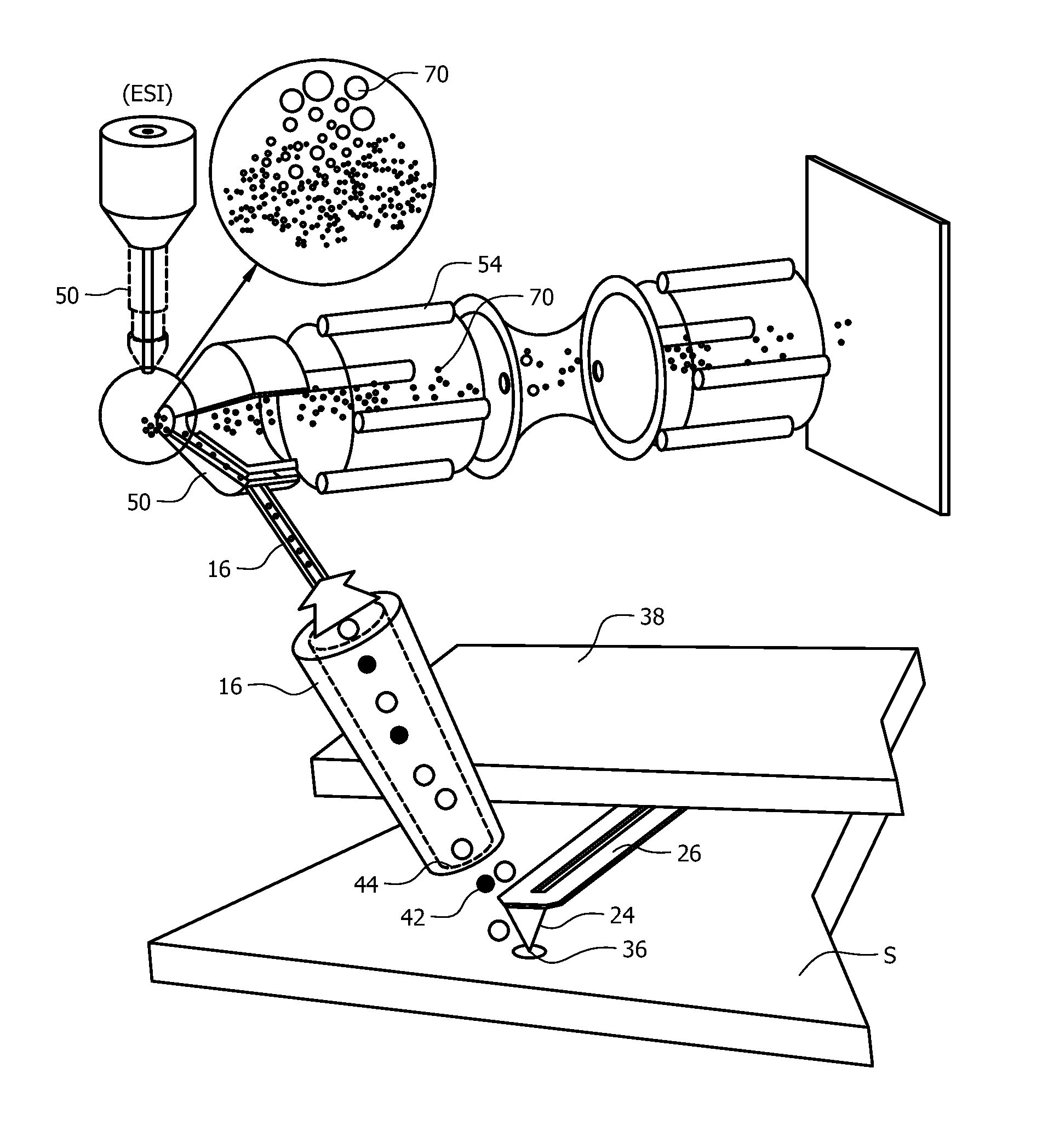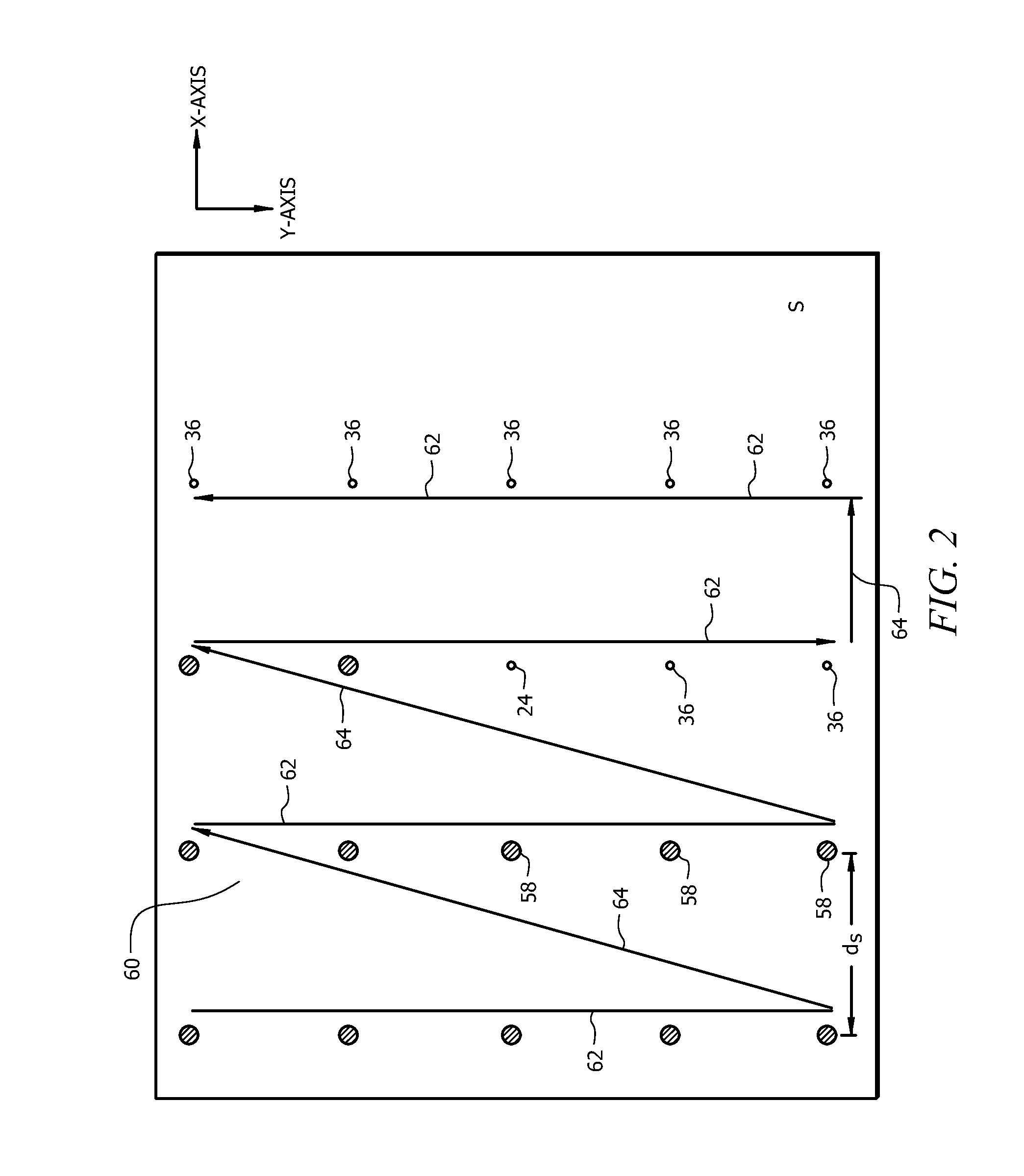Spatially resolved thermal desorption/ionization coupled with mass spectrometry
a mass spectrometry and thermal desorption technology, applied in the field of high spatial resolution analysis of the chemical composition of specimens, can solve the problems of limited chemical information resolution evaluation, limited resolution evaluation, and limited operation of high vacuum techniques
- Summary
- Abstract
- Description
- Claims
- Application Information
AI Technical Summary
Benefits of technology
Problems solved by technology
Method used
Image
Examples
example 1
[0056]Electrospray ionization (ESL) works by ionizing a gaseous sample through reaction with charged solvent droplets, protonated solvent species, or gas phase ions created in the ESI process. Besides the apparent high secondary ionization efficiency, the other advantage of using ESI is the ability to form multiply-charged species from macromolecular species.
[0057]In atmospheric pressure chemical ionization (APCI) ionization occurs by ion / molecule chemistry in a plasma that is created by a corona-discharge at the end of a metal needle. APCI is limited to forming singly-charged ions. The ionized molecules formed with either source will then be analyzed by either a quadrupole ion trap or a triple quadrupole mass spectrometer. The experimental set-up using ESI source and a Waters TQD triple quadrupole mass spectrometer is shown schematically in FIG. 6.
[0058]In order to create chemical images, software was developed to allow for point sampling as well as continuous line scanning. Point ...
example 2
[0063]FIG. 6 shows an experimental set-up for the thermal desorption process described herein. Once the material is desorbed by the thermally active tip 24 the gaseous analyte 42 will be transferred from the desorption area 36 around the heated probe to the ionization source 50 using a pump that creates a flow of gas from the collection device inlet 44 probe into the ionization source 50. The gaseous analyte 42 will then be ionized by the ionization source (ESI or ANA) best suited for the targeted small molecule being investigated.
[0064]FIG. 9(a) shows an AFM image of a specimen (S) with a caffeine coating that was analyzed using the thermal desorption technique described herein. The sampling was conducted by positioning the thermally active tip a distance of 10 μm above the individual target site and heating the thermally active tip to 350° C. The tip was then slowly lowered into contact with the target site and maintained at the surface for 30 seconds at which point the tip was co...
example 3
[0067]This Example focuses on an analysis where the specimen is a high-performance thin-liquid chromatography (HPTLC) plate.
Analyte Chemicals
[0068]HPLC grade acetonitrile was purchased from Burdick and Jackson (Muskegon, Mich., USA). HPLC grade methanol, ACS grade chloroform, toluene and methylene chloride were obtained from J. T. Baker, Inc, (Phillipsburg, N.J., USA). ACS grade acetone and ethyl acetate were acquired from EM Sciences (Gibbstown, N.J., USA). Glacial acetic acid, 99% ethanol, Sudan red 7B (CAS No, 6368-72-5), 2-acetoxybenzoic acid (aspirin, CAS No, 50-78-2) and N-(4-hydroxyphenyl)ethanamide (acetaminophen or paracetamol, CAS No. 103-90-2) were purchased from Sigma Aldrich (Milwaukee, Wis., USA), A test Dye Mixture V containing Sudan red 713, solvent green 3 (CAS No. 128-20-3), and solvent blue 35 (CAS No. 17354-14-2) in toluene was obtained from Analtech, Inc, (P / N 30-05, Newark, Del., USA). Standard solutions (1000 mg / mL in acetonitrile) of 1,3,5,7-tetranitro-1,3,5,...
PUM
 Login to View More
Login to View More Abstract
Description
Claims
Application Information
 Login to View More
Login to View More - R&D
- Intellectual Property
- Life Sciences
- Materials
- Tech Scout
- Unparalleled Data Quality
- Higher Quality Content
- 60% Fewer Hallucinations
Browse by: Latest US Patents, China's latest patents, Technical Efficacy Thesaurus, Application Domain, Technology Topic, Popular Technical Reports.
© 2025 PatSnap. All rights reserved.Legal|Privacy policy|Modern Slavery Act Transparency Statement|Sitemap|About US| Contact US: help@patsnap.com



